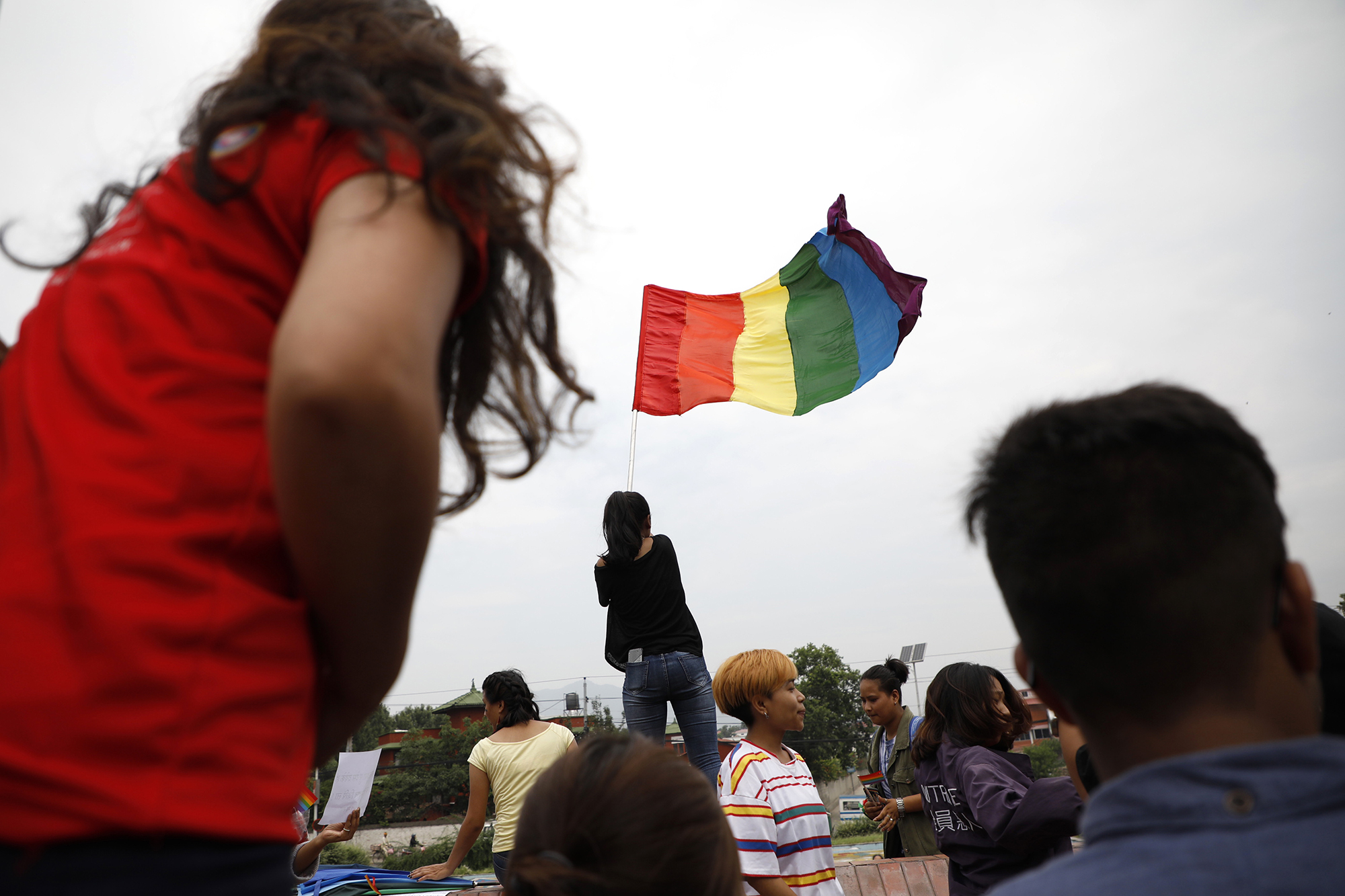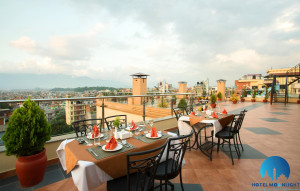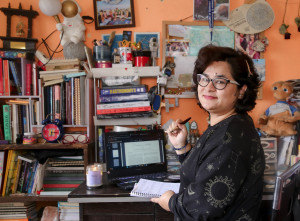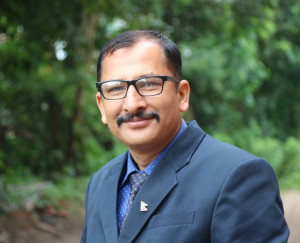Culture & Lifestyle
Looking back at the year of the pandemic for the trans movement
On the occasion of International Transgender Day of Visibility, the Post recalls the events and issues that took place last year that shaped the trans movement and its future in Nepal.
Ankit Khadgi
On the evening of January 21, when Sanju was on her way home, she saw a commotion on a street near Gongabu Bus Park. A group of police was verbally and physically abusing a group of people, among whom were some of her friends.
“I rushed to see what was happening because I heard a lot of transphobic slurs used against my friends," says Sanju, a 23-year-old transgender woman, who wants to be identified by her first name only. "The situation got out of hand quickly and before we knew what was happening the police started beating up my friends. I ran to stop the police from beating up my friends.”
But when she tried to break apart the brawl, the police started beating her too, with their boots, sticks, and even their rifle's buttstock, she says.
“That day the police didn’t treat us like human beings. Even after the merciless beatings, they arrested us and kept us in custody for more than 25 days,” says Sanju, who had to get six stitches on her head from the injuries she sustained at the hands of the police.
To the world, Nepal is often projected as a queer-friendly nation but what Sanju and her other friends experienced that day is just an example of the living realities of how transgender people are treated in the country.
From not getting their right to get citizenship as per one’s choosing of gender identity to the constant harassment and abuses that one has to face on a daily basis, Nepal, as a country, still has not been able to guarantee equal rights for its transgender population as well as provide a safe, secure and equal environment for them.
However, regardless of the struggle, many transgender activists have shown resilience and have been fighting against the injustices that have been laid against them as well as the whole queer community.
On the occasion of International Day of Transgender Visibility, the Post looks back on the events and issues involving trans people that took place last year, and how they shaped the trans movement and its future.
The woeful year of lockdown
As soon as the government announced a lockdown to control the mass transmission of coronavirus, many people were forced to live indoors. Likewise, people also lost their livelihoods. However, it was the transgender population who were among those who had to suffer the most. As most of the country's workplaces have not embraced inclusivity, many of them survive on minimum wage. When those wages also vanished due to the pandemic, they had no savings to turn to.
“The year 2020 was terrible for trans people. Many trans people had to go through social, economical, and mental problems, because of lack of jobs which made it difficult for them to even survive and get food for their living,” says Pinky Gurung, chairperson of Blue Diamond Society. “Similarly, since a lot of trans people were forced to live and move back with their families, who weren’t accepting of their identities as they couldn’t pay their rents, it was difficult for them, mentally as well,” says Gurung.
According to Gurung, as per the report gathered by her organisation, 20 trans women died by suicide while 10 others made attempts of taking their own life. Gurung believes that the current pandemic and the lockdown exacerbated stress and anguish over the already vulnerable trans people, as they were deprived of their livelihoods and freedom, affecting them on a social, economical, and psychological level.
“The pandemic just showed how challenging it is for trans people to live in our society. Although the condition of the trans community in Nepal was already vulnerable, the pandemic added more economical and mental stress in their lives,” says Gurung.
Similarly, another problem trans people had to face during the lockdown was medical complications due to the lack of gender-affirming health care facilities, like hormonal medications, available in the market. During the lockdown, the government was unable to realise that gender-affirming health care should also be a part of emergency medical services since many trans people require it for their socio-emotional wellbeing.
And as gender-affirming health facilities were scarce, many trans people suffered both physically and mentally, because of the withdrawal symptoms, which affected their mental and physical health, they said.
“As someone who is required to get hormone medication to maintain hormonal balance in my body every 21 days, it was mentally and emotionally traumatising for me to not get my shots during the lockdown due to which both of my mental and physical health were severely affected,” says Sudeep Gautam, a 27-year-old trans man.

The hope during the storm
The pandemic however didn’t stop transgender activists from carrying out their activism and helping other trans people in every possible way they could. Even during such trying times, activists kept working on advocating for equal rights for transgender people as well as helping those transgender individuals who were severely affected by the pandemic.
“As it was getting difficult for our community to even survive, we started distributing relief materials including food, money, and other basic needs to people who required help,” says Gurung. “Similarly for those who didn’t have citizenship, we approached the local government to help them. Also, with the help of the government, we also started providing an online counselling service for our community.”
Meanwhile, amidst the pandemic, many transgender activists were also at the forefront in raising their voices for transgender rights in Nepal. Tired from the forceful imposition of third gender identity by both the state and society, at the beginning of 2020, about five young transgender activists formed Trans Rights Collective, with the motive of starting an advocacy group for transgender people and their rights.
“I remember myself as a child: I knew I was a girl but I was not seen as one. In the Nepali language, I was referred to as a 'third gender' but I'd never felt comfortable with being known as one, and I knew I wasn't alone and there were many transgender people like me, who felt the same,” says Rukshana Kapali, a transgender activist, who along with four other activists started the group.
“The dissatisfaction we felt was something we wanted to do away with. That is why, in late 2019, we started to have discussions centred on creating documentation that ascribed what, why, and how our dissatisfaction with the current narrative is, and what we want.” she adds.
Through social media platforms like Facebook, the group along with other 35 transgender people started discussing the need for changing the narrative and the urgency to advocate for the rights of transgender people. Over time, they decided to take their discussions in a specific direction, and voice out their demands through legal paperwork. Thus, on the occasion of International Transgender Day of Visibility last year, the group released a National Transgender Demand Sheet, voicing seven demands, including the rights of trans men to be allowed to select 'male' and trans women to be allowed to select 'female', the right to be able to amend name and gender markers in legal documentation as well as several other concerns of language and privacy.
Likewise, on May 17 last year to commemorate the International Day against Queerphobia, the group also published the National Charter of Demands on Legal Recognition of Gender Identity, which included the concerns of intersex, transgender, non-binary, and third gender individuals as well as people who do not want to adhere to a gender marker.
“In both of these documents, we've called out the 'other gender' provision of Nepal and why it is harmful. We also declared the year Nepal Sambat 1141 as the ‘Year of Action for Recognition of Gender Identity & Against Forced Others Gender Labelling 1141’,” says Kapali, who along with other young transgender people have started to embrace the term ‘paralaignik’ to refer to transgender people in the Nepali language, which many government authorities have started using as well.
Last year, on December 19, the group also organised the Trans Pride Parade in the country, giving exposure to the issues of trans people to a wider audience.
The group also expressed its dissatisfaction and filed a complaint at the National Human Rights Commission against a directive which was issued by the Ministry of Home Affairs in 2012, as per the Supreme Court’s 2007 hearing of the Sunil Babu Pant & Others vs Government case, which enforced a provision that all the queer individuals will only be granted citizenship with ‘others’ as a gender marker.

The future of the trans movement in Nepal
Gurung stresses that for the trans movement to propel in Nepal, there should be wide support from all kinds of people, including those celebrated in societies. “The agenda for trans rights should be treated as a common public agenda,” says Gurung.
And for that Gurung believes that more transgender people should get the opportunity to participate in decision-making roles, which she believes can be possible because of the upcoming census.
“In Nepal, from rights to quotas to even budget allocation, everything is divided based on population. Hence why this year’s census is crucial is because it will count queer people as well due to which they can get the opportunity to participate in politics through proportional basis,” says Gurung.
However, the census will still fail to provide accurate data of transgender population, as there is no option for transgender people to select their preferred gender marker, as the government has just boxed all gender and sexual minorities in the ‘other’ category, classifying both gender identity and sexual orientation as one, which the trans population vehemently have been protesting against.
Likewise, since the nation’s data collection method of the census is still carried out using the traditional method, as it’s the head of the family who is mostly asked the questions, the members of the Trans Rights Collective believe that such method can’t be employed to collect data for transgender people in Nepal, as it fails to acknowledge the sensitivity and privacy concerns people can have.
And that’s why to fill the gap of misrepresentation of transgender voices, which often are underlooked by the state, media, and society at large, many young transgender activists are actively working to bring forward the real voices of transgender people as well as demand for a structural change that can foster the growth of transgender population.
“This year, on the occasion of International Transgender Day of Visibility, we are petitioning to Google India to amend some Sexual Orientation, Gender Identity, Expression and Sex Characteristics (SOGIESC) vocabularies in Google Translate's Nepali translation. Likewise, we will also write a petition to the Language Commission to make a recommendation to the Council of Ministers to legally adopt the term paralaingik, paralaingik mahila and paralaingik purush to denote transgender, trans women, and trans man in the Nepali language respectively, as well as to adopt an official definition of transgender people,” says Kapali, who along with her other queer rights advocacy group, Queer Youth Group, and intersex rights group, Campaign for Change, published a book recently that explains the concepts related to SOGIESC in the Nepali language.
Meanwhile, the group is also planning to write another petition to the Language Commission to make a recommendation to the Press Council and Ministry of Information and Communication Technology to give a directive to Nepal media houses to stop translating the term 'transgender' in English to 'tesrolingi' (third gender) in Nepali and use the correct terminology 'paralaingik', says Kapali, who is set to file a writ petition at the Supreme Court to be able to have all her documentations reflect her gender as 'female'.
Similarly, Kapali is also determined to raise concerns over deadnaming, misgendering, and various others right making it the first legal case filed in Nepal, specifically about the rights of transgender people.
Although it has been 19 years since the queer movement formally started in Nepal, the voices of the transgender population has often been neglected in our country as the narrative that ‘transgender people are third gender’ is widely accepted. And due to this many transgender people have been forced to accept a gender identity that they do not identify with.
However, now especially young transgender people are showing resilience against the unjust system of the society that fails to acknowledge their identity, by trying to bring structural changes that can help transgender people to live with dignity and equal rights.
“The violence, discrimination, stigma, and structural barriers I have endured in my life have inspired me to initiate a structural change because I didn’t want anyone else to experience what I went through,” says Kapali.




 17.12°C Kathmandu
17.12°C Kathmandu















